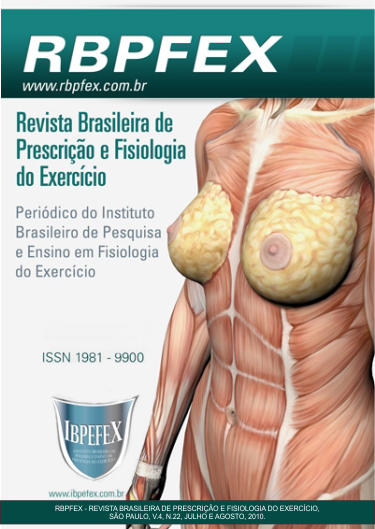The effect of cardio exercise and resistance in alteration of cholesterol an lipoproteins HDL-C, LDL-Cand triglycerides
Abstract
The dyslipidemia can raise the risk of coronary blood, disease, but physiologic modifications through the exercise can act directly on total cholesterol, HDL-cholesterol, LDL-cholesterol and Triglycerides. So the present study had the objectiveto check the effects of cardio training and resistance in alteration of total cholesterol (TC), HDL-cholesterol (HDL-C), LDL-cholesterol (LDL-C) and triglycerides level. The sample was been dividedin 3 groups made by 5 individuals, control group (CG), cardio group (AG) and resistancegroup (RG). The AG trained in treadmills with compatible velocity to 60% of high cardiac frequency, by the formula(220-age) with duration of 40 minutes, the RG made the high repetition (1RM) training on 70% of your high, the trainings were made 3 times a week, the CG didn’t make any physical activity. Was made a blood clinical exame to check the TC, HDL-C, LDL-C and TG. The results poundin AG were reductionof 7,9%, 25,2% and 18,5% on TC, HDL-C and TG, respectively, but observed a raise of LDL-C 13%. On RG observed a reduction on TC of 2,2%, HDL-C 20,9% and TG 44,1%, raising the LDL-C in 29,1%. On CG redacted1% on TC, 31,9% on HLD-C and TG of 24,4%, the only raise was on LDL-C. The study concludedthat the physical exercise, independent of cardio or resistance, can act directly in the physiological alteration of total cholesterol, HDL-C, triglycerides and also LDL-C, an appropriate control of diet it mares necessary to get real results and be presented.
References
-Boyden, T.W.; e colaboradores. Resistence Execice Training is Associated With Decreases in Serum Low-Density Lipoprotein Cholesterol Levels in Premenopausal Women. Archives of Internal Medicine. Vol. 153. Num. 1. 1993. p. 97-100.
-Brownell, K.D.; Bachorik, P.S.; Ayerle, R.S. Changes in Plasma Lipid and Lipoprotein Levels in Men and Women After a Program of Moderate Exercise. American Heart Association. Vol. 65. 1982. p. 477-484.
-Fernandez, A.C.; e Colaboradores. Influência do treinamento aeróbio e anaeróbio na massa de gordura corporal de adolescentes obesos. Revista Brasileira de Medicina do Esporte. Niterói. Vol. 10. Num. 3. 2004. p. 152-158.
-Goldberg, L.; colaboradores. Changes in Lipid and Lipoprotein Levels After Weight Training.The Journal of the American medical association. Vol. 252. Num. 4. 1984. p. 504-506.
-Guedes, D.P.; Guedes, J.E.R.P. Distribuição de Gordura Corporal, Pressão Arterial e Níveis de Lipídios-lipoproteínas Plasmáticas. Arquivo Brasileiro de Cardiologia. Londrina. Vol. 70. Num. 2. 1998. p. 93-98.
-Lira, F.S.; e Colaboradores. Consumo de oxigênio pós-exercícios de força e aeróbio: efeito da ordem de execução. Revista Brasileira de Medicina do Esporte. Niterói. Vol. 13. Num. 6. 2007. p. 402-406.
-Mcardle, W.D; Katch, F.I e Katch, V.L. Fisiologia do Exercício, Energia, Nutrição e Desempenho Humano. 5a ed. Rio de janeiro. Guanabara koogan.2003. p. 7-44.
-Parente, E.B.; e colaboradores. Perfil lipídico em crianças obesas: efeitos de dieta hipocalórica e atividade física aeróbica. Arquivo Brasileiro de Endocrinologia e Metabologia. São Paulo. Vol. 50. Num. 3. 2006. p. 499-504.
-Prabhakaran, B.; colaboradores. Effect of 14 Weeks of Resistance Training on Lipid Profile and Body Fat Percentagein Premenopausal Women.British journal of sport medicine. Vol. 33. Num. 3. 1999. p. 190-195.
-Prado, E.S; Dantas, E.H.M. Efeito dos exercícios físicos aeróbios e de força nas lipoproteínas HDL,LDL e lipoproteína(a).Arquivo Brasileiro de Cardiologia. São Paulo. Vol. 79. Num. 4. 2002. p. 429-433.
-Rique, A.B.R; Soares, E.A; Meirelles, C.M. Nutrição e Exercício na Prevenção e Controle das Doenças Cardiovasculares. Revista Brasileira de Medicina do Esporte. Niterói. Vol. 8. Num. 6. 2002. p. 244-254.
-Sanches-Quesadaac, J.L.; colaboradores. LDL from aerobically-trained subjects shows higher resistance to oxidative modification than LDL from sedentary subjects. Atherosclerosis. Vol. 132. Num. 2. 1997. p. 207-213.
-Vasankari, T.J.; colaboradores. Reduced oxidized LDL levels after a 10-month exercise program. Medicine and science in sports and exercise. Vol. 30. Num. 10. 1998. p. 1496-1501.
-Ziogas, G.G.; Thomas, T.R.; Harris, W.S. Exercise training, postprandial hypertriglyceridemia, and LDL subfraction distribution. Medicine & Science in Sports & Exercise. Vol. 29. Num. 8. 1997. p. 986-991.
Authors who publish in this journal agree to the following terms:
- Authors retain the copyright and grant the journal the right of first publication, with work simultaneously licensed under the Creative Commons Attribution License BY-NC which allows the sharing of the work with acknowledgment of the authorship of the work and initial publication in this journal.
- Authors are authorized to enter into additional contracts separately for non-exclusive distribution of the version of the work published in this journal (eg, publishing in institutional repository or book chapter), with acknowledgment of authorship and initial publication in this journal.
- Authors are allowed and encouraged to post and distribute their work online (eg, in institutional repositories or on their personal page) at any point before or during the editorial process, as this can bring about productive change as well as increase impact and impact. citation of published work (See The Effect of Free Access).






